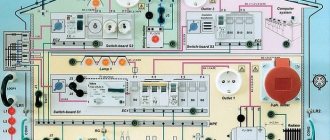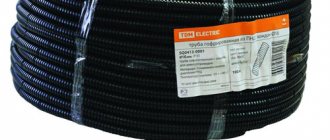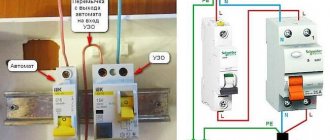Electric Shock Hazard
As an example, let's look at this case. Let's say that an automatic washing machine is installed in the bathroom. Quite a common situation, wouldn’t you agree?
Everything is fine. Washing machine operating current
When the machine is connected to the electrical network, the current will flow through the phase wire to the electric motor and return through the neutral conductor (conditionally). The neutral conductor in the electrical panel is connected to the neutral bus, to which the grounding contact in the socket is also connected. That is, the body of the washing machine is somehow connected to the zero bus.
Let's not bloat the article. The figure does not show the grounding system. It is assumed that the electrical panel is shown at the entrance to the building and the PEN conductor is re-grounded. That is, “the functions of the zero protective and zero working conductors are combined in one conductor in some part of it,” and then (after the electrical panel and in the entire apartment) – the zero protective PE and the zero working are different conductors.
Such a connection is necessary for the correct operation of the circuit breaker and/or UDT (RCD or difavtomat) if insulation damage occurs.
A little about terminology. a leakage current will flow through the ground wire in any case . This current occurs because the insulation inside the washer does not have infinite resistance. In addition, at the input of many devices there is a capacitive filter, which in its design and circuit design has a small current to ground.
If an emergency occurs, the emergency current through the grounding conductor will be called ground fault current (do not confuse it with short circuit current!).
The combination of these currents is called differential current , to which a differential current device can react - VDT (RCD) or difavtomat (RCBO).
I talked in detail about all these currents in the article What current triggers the RCD?
What bad things can happen
Electricians, as usual, cannot live in peace until they provide protection from all possible dangerous situations.
In fact, the two most dangerous emergency situations are possible:
- Voltage on the pipe - the body is grounded (potential drift),
- Voltage on the body - the pipe is grounded.
On various metal surfaces, voltage can appear not only due to breakdown of insulation, but also from the presence of static electricity or when induced or stray currents appear.
Let's consider the first case. Due to the potential difference, an accident may occur - current will flow from the pipe through the human body to the grounded body.
Current through a person from a pipe to a grounded body
What will happen to a person if he simultaneously touches the water supply pipe and touches the washing machine? To receive an electric shock, even a small potential difference between the machine body and the metal pipe will be sufficient.
The electric current will pass along a dangerous path - from one hand to the other. In either of the two examples described, current can flow through the heart and cause fibrillation (heart failure).
On the other hand, metal pipes for water supply or heating, as well as similar engineering systems, are usually grounded, that is, they have a potential equal to zero. And if for some reason a dangerous potential appears on the body of the washing machine, the current will flow conditionally in the other direction:
Phase on the body - the cause of current through a person to grounded objects
Why “conditionally”? Because the “direction” of the current, the reason and the flow pattern are not important. What is important is the fact of current flow and its meaning.
It is not necessary that one of the conductive parts must be grounded in order to create a critical potential difference (more than 50 V). It may happen that in relation to the ground there will be 50 V on the pipe, and 150 on the body of the washing machine. And here it is - a deadly potential difference of 100 V!
It may happen that the break occurs not after the tire, as shown with a cross in the picture above, but BEFORE - in or before the floor panel (where the word “PEN” is written in the picture). If the working and protective neutral conductors (N and PE) are connected after the break point (for example, in an entrance or apartment panel), then the phase potential will appear not only on the neutral, but also on the protective conductor. This means - on the housings of all grounded devices and structures. I talked about this in detail in the article What is the difference between a neutral break in three-phase and single-phase networks?
What can be done to prevent this unfortunate fact from happening? It is logical that for this it is necessary that there is no potential difference between those open conductive parts where it can appear.
What can happen will definitely happen. Moreover, even things that (seem) can never happen can happen.
Factors that determine the difference
All devices that produce electricity have zero connection to the physical ground. This means that there is a potential difference between the phase wire and the ground, which is equal to the phase voltage. The phenomenon of potential difference can be caused by many factors:
- local accidents of electrical equipment;
- static electricity;
- natural electrical potential;
- stray currents;
- currents associated with electrochemical corrosion.
Local accidents of electrical equipment are accompanied by : breaks in electrical wires, partial breakdowns of insulating underground cables, malfunction of electrical equipment located in the apartment. Plumbing fittings that are connected to PVC pipes may have a static charge due to the constant movement of water through them. The acrylic coating of bathtubs or other containers accumulates a charge of electricity on their surfaces.
Everything that is on the earth, as well as in its atmosphere, is endowed with natural electrical potential, since the earth’s shell has a negative potential, and the dome of the sky has a positive potential. The higher the physical body is, the greater the value of its potential, for example, at a height of 2 m the indicator reaches 110 volts.
Stray currents appear on paved electric transport tracks. In this case, the rails act as grounding bars. Through them, the current driving the electric motors of the cars penetrates into the ground. People living near tram lines may feel a tingling sensation in their fingers when washing their face.
If the system consists of pipes made of different materials, galvanic corrosion currents may be generated. They are not dangerous to humans, but they destroy plumbing and shut-off valves. When connecting a steel heated towel rail to a line of pipes made of ferrous metal, over time a leak will form in their connections due to loosening of the threads.
Why do you need SOUP?
To prevent such dangers, the potentials should be equalized. For this purpose, the Potential Equalization System (CPS) is used.
According to clause 6.1.1 SP 437.1325800.2018 :
When designing each electrical installation of a building, provision must be made for protective potential equalization, which usually includes a main potential equalization system and, if necessary, an additional potential equalization system . Under appropriate conditions, it may be necessary to use local potential equalization .
According to clause 1.7.32 of the PUE:
Potential equalization is the electrical connection of conductive parts to achieve equality of their potentials. Protective potential equalization is potential equalization performed for electrical safety purposes.
According to clause 1.7.51 of the PUE , potential equalization is a measure of protection in the event of indirect contact (in case of insulation damage or other emergency). It also says that it is advisable to use equalization in conjunction with other protective measures (my interpretation).
The principle of operation of the potential equalization system is to connect various conductive parts that a person can touch to the neutral protective conductor (PE). The “conductive parts” referred to in the PUE are the housings of electrical appliances, pipes, and various metal structures. In addition, concrete floors in which an electric heated floor is embedded also fall under this requirement. But this is no longer equalization, but equalization of potentials .
Yes, all these conductive parts are not normally energized and do not pose a danger. But, if during any accident (for example, deterioration of insulation) they come under dangerous voltage, then there will be trouble - they will conduct current not only through themselves, but also through anything, including the human body. Therefore, in advance (yes, electricians are still pessimists) all current-carrying parts are connected by PE conductors to a PE bus - this is the shortest and “convenient” distance for dangerous current to flow to the ground electrode.
According to clause 3.28 of SP 437.1325800.2018 and article 3.15 of GOST IEC 61140-2012 :
Hand Reach Zone: The zone of accessible touch extending from any point on a surface on which a person normally stands or moves to the limit that he can reach with his hand in any direction without the use of aids.
In ordinary household wet and damp rooms, the reach zone is the entire room. It is important that within the reach zone there is not a single object left capable of conducting current that is not connected by a protective grounding wire to the control system and, ultimately, to the main generator.
Operating principle and installation of PMC
To prevent the formation of potential differences, a control box is installed in the premises. The principle of operation of the device is the parallel connection of all structures made of metal. The PMC box combines all conductive objects into a single circuit.
Installing a potential equalization system at home is not difficult. It was called the local system. It is recommended to install such a structure during renovations in an apartment, since it is required to run a wire under the floors from the distribution panel to the control panel.
To install the unit, you will need the following tools and materials:
- Fastening connections – fixing tabs, clamps, bolts. They are used to connect the wires of the entire circuit.
- Terminal box with a busbar made of copper (SHDUP).
- Single-core copper wires. The cross-sectional area of such cables should range from 2.5 – 6 mm2, brand – PV1.
If all the necessary equipment is prepared, you can begin installation. A connection diagram is first drawn up in order to properly equalize the potentials. The locations of the cables from the box to the grounding bus in the distribution board are also schematically shown.
The next stage is preparation for connecting the communications themselves. Clean the contact areas until a characteristic metallic shine is formed.
This is important because it ensures a reliable connection. In an abnormal, emergency situation, the potential equalization system will not fail
Connect cables to each part of the circuit. All conductors are inserted into the box and made a reliable connection to the bus.
The best option is to install the system during the construction phase of the building, however, there are restrictions on its use:
- It is prohibited to install in houses where a TN-C type grounding system with a PEN conductor is installed.
- If plastic pipes made from polyethylene are installed at home, they will break the circuit, resulting in an electric shock.
The cross-sectional area of the conductor used must be no less than the recommended value.
What is GZSH?
To take a closer look at the purpose, types and structure of the MUP, let’s find out in more detail what the Main Grounding Bus (GGB) is. After all, it is the GZSh that is the basis of the entire safety system in any electrical installation. The connection to the GZSh is made by protective PE conductors, which are connected to the GZSh, the role of which is usually played by the PE bus (PUE, 1.7.119) .
GZSh and PE bus are in fact the same thing if it is located inside the input switchgear (IDU). And only if the GZSh is located somewhere outside the ASU (somewhere at the entrance to the building, in the basement), can there be two buses - GZSh and PE. Moreover, there is usually one GZSh (according to the number of inputs into the building), and several PE busbars (according to the number of electrical panels).
Simplified, it might look like this:
Grounding system and buses N and PE
This system ensures that all connected parts have the same potential. The voltage between any individual points in such a system is guaranteed to be zero.
The definition of GZSh is given in clause 1.7.37 of the PUE and in GOST 30331.1-2013, article 20.5 :
The main grounding bus is a bus that is part of the grounding device of an electrical installation up to 1 kV and is intended for connecting several conductors for the purpose of grounding and potential equalization.
Requirements for GZSh are reflected in paragraph 1.7.119 of the PUE:
The main grounding bus can be made inside the input device of an electrical installation with voltage up to 1 kV or separately from it. Inside the input device, a PE bus should be used as the main grounding bus.
When installed separately, the main grounding bus must be located in an accessible, convenient place for maintenance near the input device.
The cross-section of a separately installed main grounding bus must be no less than the cross-section of the PE (PEN) conductor of the supply line.
The main grounding bus should, as a rule, be copper. It is allowed to use a main grounding bus made of steel. The use of aluminum tires is not permitted.
The design of the bus must provide for the possibility of individual disconnection of the conductors connected to it. Disconnection must only be possible using a tool.
In places accessible only to qualified personnel (for example, switchboard rooms of residential buildings), the main grounding bus should be installed openly. In places accessible to unauthorized persons (for example, entrances or basements of houses), it must have a protective shell - a cabinet or drawer with a key-locked door. There must be a “Grounding” sign on the door or on the wall above the busbar.
A description of the term “Grounding device” can be found in SP 437.1325800.2018 clause 3.14 and in GOST 30331.1-2013, article 20.14:
Grounding device : A set of grounding conductors, grounding conductors and the main grounding bus.
The GZSh is usually connected to the ground loop by a steel strip or copper conductor. The PEN conductor of the input cable (when using the TN-CS grounding system) or the PE conductor of the input cable (if using the TN-S grounding system) is connected to it. Or - a grounding conductor from a ground electrode in the TT system.
Inside the ASU, PE conductors of outgoing group lines and PE conductors serving for potential equalization are connected to the main switch.
To ensure safety, there is a rule: one PE wire - one connection (screw or bolt).
A radial connection diagram should be used - that is, the protective conductor cannot be “circulated”, connecting it in series to various protected structures. The main requirement for PE conductors is to ensure their continuity throughout. Therefore, the installation of any switches, switches, fuses and connections that can be disassembled without the help of a tool is prohibited.
The GZSh at the entrance to a building or other electrical installation can be like this:
GZSh at the entrance to the electrical installation
In the photo above there is a GZSh at the power input to the production line. I published an article about the reasons and process for replacing the input machine in this line.
Question for experts: What grounding system is shown in the diagram?
Power supply of the technological line, input circuits
Types of potential equalization systems
There are two types of potential equalization systems (PES) - the main (OSUP) and the additional system (DSUP). Let's look at each in more detail and figure out what the difference between them is.
BPCS
According to paragraph 1.7.82 of the PUE:
The main potential equalization system in electrical installations up to 1 kV must connect the following conductive parts:
- neutral protective PE or PEN conductor of the supply line in the TN system;
- a grounding conductor connected to the grounding device of an electrical installation in IT and TT systems;
- a grounding conductor connected to the re-grounding electrode at the entrance to the building (if there is a ground electrode);
- metal pipes of communications entering the building (...). If the gas supply pipeline has an insulating insert at the entrance to the building, only that part of the pipeline that is located relative to the insulating insert on the side of the building is connected to the main potential equalization system;
- metal parts of the building frame;
- metal parts of centralized ventilation and air conditioning systems. If there are decentralized ventilation and air conditioning systems, metal air ducts should be connected to the PE bus of the power supply panels for fans and air conditioners;
- grounding device of the lightning protection system of the 2nd and 3rd categories;
- grounding conductor of functional (working) grounding, if there is one and there are no restrictions on connecting the working grounding network to the protective grounding device;
- metal sheaths of telecommunication cables.
Conductive parts entering the building from the outside must be connected as close as possible to the point of their entry into the building. The connection of the conductive parts of the main potential equalization system must be carried out according to a radial diagram, i.e. Each conductive part must have a separate grounding conductor from the PE bus.
If we take it in large terms, then the BPCS consists of:
- Main grounding bus (GZSh).
- Grounding device.
- Protective PE conductors that are connected to the housings of electrical appliances (to open conductive parts ).
- Potential equalization conductors , which are connected to third-party conductive parts (various structures that are not part of the electrical installation).
The BPCS might look like this:
The main SUP - in the center of which there is a GZSh
OSUP is a control system that is based on a GZSh or PE bus. In this case, potential equalization conductors are separately connected to this bus, and protective PE conductors can be connected both to the main shield and to the PE bus, if it is available separately (as shown above).
If the GZSh and the PE bus are one and the same (this may be the case in a small private house), then both protective conductors and potential equalization conductors are connected to it:
PE tire as a main bus in a small building
DSUP
This system, as the name suggests, serves to complement the BPCS. DSUP is used for rooms where there is an increased risk of electric shock. At the same time, in this room there are many open and third-party conductive parts that require potential equalization. An example is the same bathroom that we looked at at the beginning of the article.
DSUP - additional potential equalization system in the bathroom
The system consists of potential equalization conductors, which are connected through a potential equalization box (PEB).
When creating a DSUP, you need to connect the PE bus located in the control unit with a PE or GZSh bus using a copper wire with a cross-section of at least 6 mm2. Next, potential equalization conductors connect all metal surfaces and all engineering systems (more precisely, open and third-party conductive parts) located in the room.
The ground contacts of electrical outlets in the bathroom can also be connected to the DSUP. But this is usually done by PE conductors leading into the power cable.
According to paragraph 7.1.88 of the PUE ,
For bathrooms and shower rooms, an additional potential equalization system is mandatory and must include, among other things, the connection of third-party conductive parts extending outside the premises. If there is no electrical equipment with neutral protective conductors connected to the potential equalization system, then the potential equalization system should be connected to the PE bus (clamp) at the input. Heating elements embedded in the floor must be covered with a grounded metal mesh or a grounded metal shell connected to a potential equalization system. As additional protection for heating elements, it is recommended to use an RCD with a current of up to 30 mA.
In addition, “it is not allowed to use local potential equalization systems .” But we will talk about this in the next article!
How it works
Let's assume that all sockets and electrical appliances in your apartment are grounded. In theory, you feel safe. Your downstairs neighbor, while carrying out repairs, replaced the sewer pipe from cast iron to plastic. There is now no reliable electrical connection between your cast iron bathtub and the physical ground. A neighbor's insulation in a chandelier broke, and through the wet floor of your bathroom, a potential of about 100 volts appeared in the bathtub with water.
Since there is a plastic insert in the sewer drain, there was no ground fault and the circuit breaker did not trip. All the potential has accumulated in your bathroom. While you are in the water, you touch the faucet. Through steel water pipes, it has a reliable electrical connection with the ground. You receive a guaranteed electric shock.
Why did it happen?
Any conductor contains electrons. As long as there is no difference in potential at the ends of the conductor, the electrons stand still and no current flows. In the described situation, the water pipe has zero potential along its entire length. A bathtub of water, due to the spread of voltage from faulty wiring on the floor below, through a section of cast iron pipe, has a potential of 100 volts. These objects do not touch each other, so there is no electric current.
After touching both a live bathtub and a virtually grounded faucet, an electrical current flows through your body. A person is 80% water, so he is quite a good conductor. Electrons simply rush from a point with a lower potential to a point with a higher potential
Therefore, special attention should be paid to equalizing potentials in the bathroom.
In fairness, if you simply ended up with a energized bathtub (without touching anything), and also left it, there would be no electric shock. Have you ever wondered why birds sitting on power lines with voltages over 1000 volts do not die from electric shock? Because they have the same potential as a wire: 1000 volts. They do not touch other wires, there is no potential difference, and accordingly, there is no electric current through their carcasses.
One more example. Insert a piece of wire (in phase) into the disconnected socket and hang it loosely so that it does not touch the wall or floor. Apply voltage and nothing will happen. However, there is a potential of 220 volts along the entire length of the wire. If you connect the wire to any object whose potential relative to the “ground” is lower, current will flow through the connector (for example, a person).
Hence the conclusion: any objects that are not energized under normal conditions (except in emergency situations) must always have equal potential. In the case of residential premises - equal to zero. To do this, all metal elements of a residential building, including reinforcement in the walls, are connected to the ground loop during the construction stage.
This is called: the main potential equalization system (EPS). Near each building there is a main grounding bus (GGB), securely (usually by welding) connected to the grounding conductor (circuit). It is periodically checked by special services (over time it can crumble due to corrosion), and is installed at the stage of laying the foundation.
You can be sure that all metal objects in your high-rise building have electrical contact with the main building block. Immediately after commissioning, the potential equalization circuit works flawlessly. This requirement of the Electrical Installation Rules is always observed. Apartment renovations have not yet begun.











